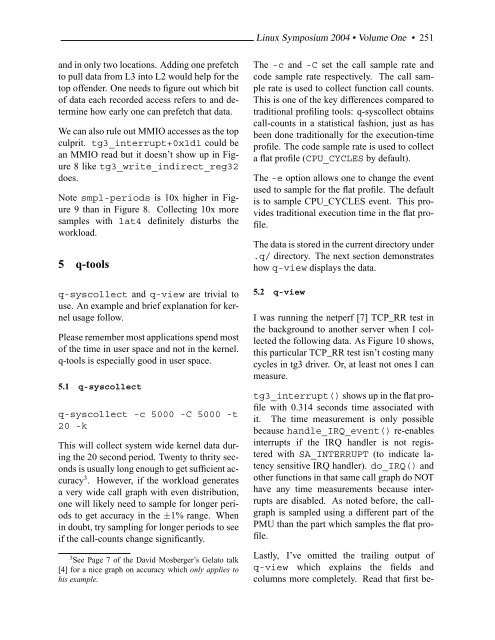Create successful ePaper yourself
Turn your PDF publications into a flip-book with our unique Google optimized e-Paper software.
<strong>Linux</strong> Symposium 2004 • Volume <strong>One</strong> • 251<br />
and in only two locations. Adding one prefetch<br />
to pull data from L3 into L2 would help for the<br />
top offender. <strong>One</strong> needs to figure out which bit<br />
of data each recorded access refers to and determine<br />
how early one can prefetch that data.<br />
We can also rule out MMIO accesses as the top<br />
culprit. tg3_interrupt+0x1d1 could be<br />
an MMIO read but it doesn’t show up in Figure<br />
8 like tg3_write_indirect_reg32<br />
does.<br />
Note smpl-periods is 10x higher in Figure<br />
9 than in Figure 8. Collecting 10x more<br />
samples with lat4 definitely disturbs the<br />
workload.<br />
5 q-tools<br />
q-syscollect and q-view are trivial to<br />
use. An example and brief explanation for kernel<br />
usage follow.<br />
Please remember most applications spend most<br />
of the time in user space and not in the kernel.<br />
q-tools is especially good in user space.<br />
5.1 q-syscollect<br />
q-syscollect -c 5000 -C 5000 -t<br />
20 -k<br />
This will collect system wide kernel data during<br />
the 20 second period. Twenty to thrity seconds<br />
is usually long enough to get sufficient accuracy<br />
3 . However, if the workload generates<br />
a very wide call graph with even distribution,<br />
one will likely need to sample for longer periods<br />
to get accuracy in the ±1% range. When<br />
in doubt, try sampling for longer periods to see<br />
if the call-counts change significantly.<br />
3 See Page 7 of the David Mosberger’s Gelato talk<br />
[4] for a nice graph on accuracy which only applies to<br />
his example.<br />
<strong>The</strong> -c and -C set the call sample rate and<br />
code sample rate respectively. <strong>The</strong> call sample<br />
rate is used to collect function call counts.<br />
This is one of the key differences compared to<br />
traditional profiling tools: q-syscollect obtains<br />
call-counts in a statistical fashion, just as has<br />
been done traditionally for the execution-time<br />
profile. <strong>The</strong> code sample rate is used to collect<br />
a flat profile (CPU_CYCLES by default).<br />
<strong>The</strong> -e option allows one to change the event<br />
used to sample for the flat profile. <strong>The</strong> default<br />
is to sample CPU_CYCLES event. This provides<br />
traditional execution time in the flat profile.<br />
<strong>The</strong> data is stored in the current directory under<br />
.q/ directory. <strong>The</strong> next section demonstrates<br />
how q-view displays the data.<br />
5.2 q-view<br />
I was running the netperf [7] TCP_RR test in<br />
the background to another server when I collected<br />
the following data. As Figure 10 shows,<br />
this particular TCP_RR test isn’t costing many<br />
cycles in tg3 driver. Or, at least not ones I can<br />
measure.<br />
tg3_interrupt() shows up in the flat profile<br />
with 0.314 seconds time associated with<br />
it. <strong>The</strong> time measurement is only possible<br />
because handle_IRQ_event() re-enables<br />
interrupts if the IRQ handler is not registered<br />
with SA_INTERRUPT (to indicate latency<br />
sensitive IRQ handler). do_IRQ() and<br />
other functions in that same call graph do NOT<br />
have any time measurements because interrupts<br />
are disabled. As noted before, the callgraph<br />
is sampled using a different part of the<br />
PMU than the part which samples the flat profile.<br />
Lastly, I’ve omitted the trailing output of<br />
q-view which explains the fields and<br />
columns more completely. Read that first be-

















